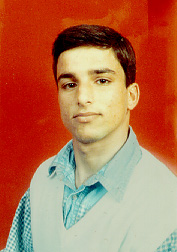
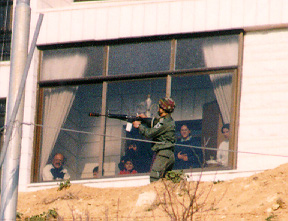
I notice a family standing in their living room window as a soldier directly outside shoots rubber-coated metal bullets at demonstrators nearby (pictured left). Everyone is pressed against the glass - a grandparent, two parents and two children - all watching the soldier shooting right outside, framed in their living room window. A completely surreal scene. Hey, it's Reality TV.
There is something different today. The unmistakable crack of live ammunition rings out very sporadically. It's unhinging because there is no need for it. No soldier above us is in a life-threatening situation.
The demonstrators are careful not to get too close to the soldiers in this mostly open ground as they themselves don't want to get injured, and they know the range of the soldiers' weapons is extensive.
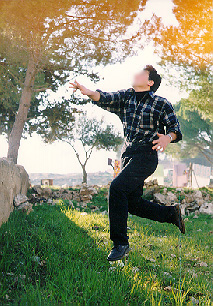
As a result, it is clear today that ninety-five percent of the stones that are thrown will fall far short of the target area.
Out of the remaining five percent that reach the target area, ninety-five percent will have spent any energy they had and will skittle across the ground at the soldiers' feet.
Out of the five percent that do reach the area with force, ninety-five percent will miss.
Of the five percent of these that hit a soldier, I guess that ninety five percent will hit a soldier's body armor, helmet or weapons.
Calculation? 0.000625% of stones will graze off or cause light injuries and maybe one in 10 of these might cause a serious injury.
In other words, one chance in 16,000 that a Palestinian stone will seriously injure an Israeli soldier today.
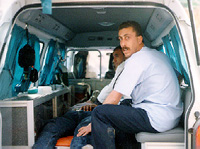
Out of the thousands of stones I saw thrown, I only saw one bounce off one soldier's helmet today. On Wednesday, someone told me that a they saw a soldier with a bloody nose. That was it.
This has been the pattern for every single demonstration I have witnessed in my time in the West Bank.
Judge for yourselves if this constitutes a life-threatening situation. Yet now the soldiers are shooting live ammunition. What's going on? The face of this medic from a Palestinian ambulance (pictured above left) should give us a clue.
Meanwhile, the students and others on top are continuing their stone throwing. Israeli soldiers fire rubber bullets. Again, I hear the crack of gunfire.

I am en route to the main group of demonstrators on the road, away from the journalists' camp positioned below the Israeli troops. An Israeli soldier above us is pointing his gun at a demonstrator in between myself and my destination. To carry on at this moment would mean having to run through his line of fire, something I am not quite prepared to do.
Suddenly, from the mountain area I have just been photographing (pictured above), the students begin to shout that desperate word - As'aaf! As'aaf! As'aaf! ("Ambulance! Ambulance! Ambulance!") - and a huge group, much larger than usual, carry the injured person down.
Several run to photograph through the soldiers' line of fire. I stand still. The one-minute delay will mean I don't get the photograph and, in the year ahead, I would come to regret this.
The injured person - I find out shortly afterwards - was shot in the chest with live ammunition from 80-100 meters away. He was a 20-year-old electrical engineering student from Birzeit, called Abdullah Khalil Abdullah Salah.
The irony is that Abdullah was from Beit Sahour, the small town next to Jebal Abu Ghnaim, the place that started all of this. When the shot was fired, he and a friend nearby both hit the ground, but Abdullah didn't get up afterwards.

"Get up!" his friend shouted at him, "Get up!" until he realised that he had been wounded. He reported, to the Human Rights Action Project at Birzeit University that:
"I saw the wound by his heart, exactly on his heart. Still I thought it was only an injury - the wound did not seem very big, just on his heart. Then I leaned over to pick him up to take him to the ambulance. I saw the blood coming from his mouth. Lots of blood coming from his mouth. That's when I realised he was martyred. It was just like it was for Yasser [Abdul Ghani]."

Students were crying and in shock. Every ambulance became a source of information, with crowds surrounding it asking for news (pictured right). We went to the hospital, knowing that this guaranteed an escalation in the coming days.
Why did the soldier shoot him? As was to emerge in the press the next day, there are clear open-fire orders given by Israel: life-threatening situations only. This usually means that they are supposed to shoot at people's legs first. Surely, shooting a stone thrower in the chest from 80-100 meters away wouldn't count?
The university later commended news of an investigation, although it is unlikely it will lead to anything.
Kifah suggested a theory. He had seen a soldier running after Abdullah earlier, who had tripped and rolled down a slope. Naturally, this small victory for unarmed demonstrators would have elicited a gale of laughter. Kifah therefore suggested it was a dignity issue for the soldier, who had wanted to make the student pay for the shame he felt.
So he shot him from 100 yards away. I believe it was the same soldier that is pictured outside the family home at the top of this page.
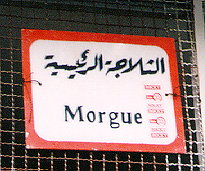
His friends were outside the hospital morgue, waiting to see his body. When the door was finally opened, at about half past seven, journalists were also allowed in to photograph, before Abdullah's body was taken to Beit Sahour. Yasser, the university photographer, took a photo without a flash.
Ahmed, the student who was injured last September and who I spoke to at the beginning of the demonstration, was one of the friends of Abdullah waiting. The connections didn't end there. Abdullah had been with Yasser Abdul Ghani last September, when Yasser was fatally shot with live ammunition. Back in my house, 'Ala, Kifah and my flatmate, had lived and studied with Abdullah.
That night in our house we drank some arak, sang Palestinian songs, listened to 'Ala's stories about Abdullah and, most of all, tried to forget the pain of living in a country where the nightmares never goes away.
